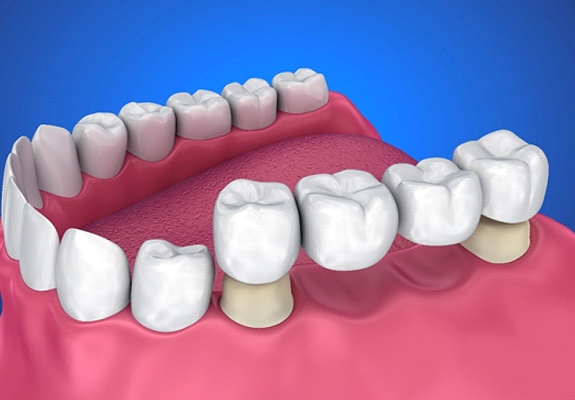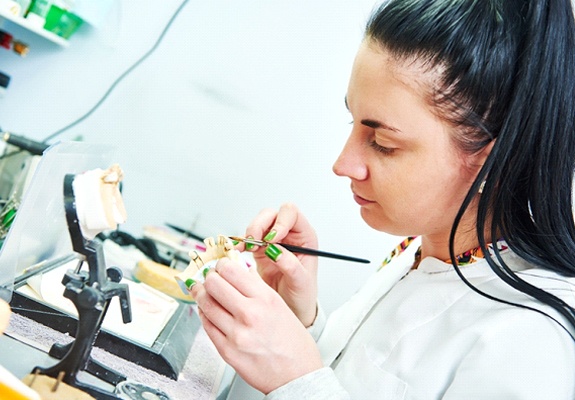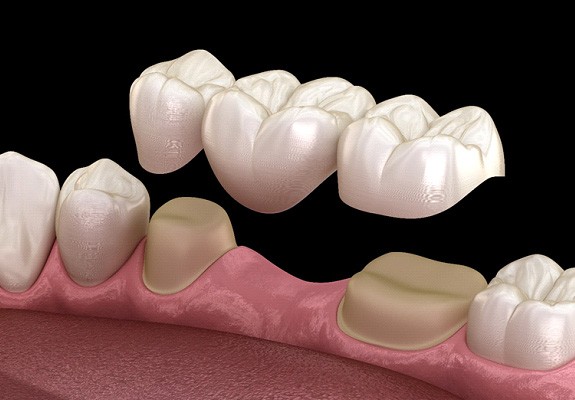Dental Bridge – Fanwood, NJ
Restoring Smiles with Customized Restorations
Are you missing one or several consecutive teeth? Do you find yourself keeping your mouth closed when it’s time to take pictures? Missing teeth can be embarrassing, and at Scotch Plains Fanwood Dental Care, we know and understand how an incomplete smile can negatively impact your self-esteem. This is why we’re proud to offer our patients a viable solution to rebuilding their smile – a dental bridge! Using your natural teeth to serve as anchors for the customized restoration, we can help you “bridge the gap” and construct a fully restored smile. Find out how we can help you by calling us to schedule an appointment today.
Why Choose Scotch Plains Fanwood Dental Care for a Dental Bridge?
- Customized restorations for your individual needs
- Fully restored smile and facial appearance
- Insurance and financial available
Who is a Good Candidate for Dental Bridges?

Prior to being fitted for a dental bridge, it is imperative that your dentist first examine your smile. Gathering as much information as possible via a visual exam and X-rays, our team will investigate the area with the missing teeth and determine the status of your oral health. There are a few things that will need to be considered before you move forward with receiving a dental bridge, including:
- Your oral health – If you have gum disease or tooth decay, it will be necessary to take care of these issues before receiving your dental bridge.
- Your overall health – Our team will want to know more about your overall health to make sure you’re in good shape to receive this customized restoration.
- No Gum Disease – Because your dental bridge will sit on your gums, they need to be healthy. If gum disease is allowed to develop, this can negatively impact your bridge.
- Consecutive Missing Teeth – In order to have a traditional dental bridge placed, the missing teeth must be consecutive.
What is the Procedure for a Dental Bridge?

A typical dental bridge procedure will take two appointments. The first visit will require that our dentists alter your healthy teeth that sit on either side of the gap. The reason for this is because the customized bridge must snugly fit over your natural teeth. Once they’ve filed down your teeth, impressions will be taken to send to the dental lab. There, technicians will use the impressions to build a dental bridge using three dental crowns that are fused together.
After several weeks, you will return to have your permanent bridge put into place. The two outer crowns will fit over your natural teeth while the other crown(s) will sit on top of your gums. You can expect your regular teeth to stay in place and not shift thanks to your new restoration.
What Are the Benefits of Dental Bridges?

When it comes time to restore your smile, you want a solution that offers the greatest array of benefits, right? Fortunately, a dental bridge can give you a more affordable way to complete your smile and increase your confidence. We know there are other options available such as an implant-retained bridge, but here are some of the many benefits associated with a traditional bridge:
- Improve appearance and increase confidence
- Maintain facial shape
- Recover bite strength and evenly distribute bite force
- Prevents a shift in your natural teeth
- Enables you to speak clearly and chew confidently
Dental Bridges FAQs

Can I Take Dental Bridges Out?
Dental bridges are not meant to be removed by the patient. Once placed, they are intended to stay in your mouth for many years. Only a dental professional should remove or adjust a dental bridge. It's important to note that sometimes partial dentures are mistakenly referred to as "removable bridges." However, this terminology is not entirely accurate. Partial dentures and bridges may serve similar purposes, but a significant difference is that partials are designed to be removed by the patient, unlike dental bridges.
Is a Partial Denture the Same as a Dental Bridge?
A partial denture is not the same as a bridge, despite sometimes being referred to as a "removable bridge." The main differences between the two are in their design and function. A bridge is a fixed dental appliance, meant to stay in place for many years and can only be removed by a dentist. In contrast, a partial denture is designed for the patient to remove and replace at will.
Bridges are typically used to replace a series of missing teeth that are next to each other, using crowns anchored over adjacent natural teeth for support. On the other hand, partial dentures can replace multiple missing teeth, even if they are not consecutive, and are usually held in place by metal clips or clasps that attach to the natural teeth.
Your dentist will assess your specific dental needs to determine which option, a bridge or a partial denture, is more suitable for you.
Can Dental Bridges Be Whitened?
Dental bridges, regardless of their material, cannot be whitened in the same way as natural teeth. This is because, unlike tooth enamel which has pores allowing bleaching agents to remove stains, dental bridges lack such a structure and thus maintain their original color. Metal-free bridges are specifically designed to match the color of your natural teeth closely. To ensure that your bridge matches well with your natural teeth, it's advisable to consider teeth whitening before the bridge is placed. This approach allows the bridge to be matched to your teeth's ideal shade, minimizing any noticeable difference in color.
Can Dental Bridges Be Helpful So Far?
While a dental bridge itself cannot develop cavities, the natural teeth underneath it are still susceptible. Food particles can get trapped under the bridge or where the crowns meet the gums, attracting bacteria that could cause cavities or gum infections. This risk is heightened with inadequate oral hygiene, emphasizing the importance of daily cleaning around and under the bridge. Additionally, as a bridge ages and the cement holding it begins to deteriorate, bacteria can enter these cracks, potentially leading to infection or decay in the teeth beneath the bridge.
I Need a Checkup & Cleaning I Have a Broken or Chipped Tooth I Want a Straighter Smile I am Looking for a Dentist for My Child I Want to Improve My Smile I am in Pain & Need Help I am Missing One or More Teeth I am Nervous/Afraid of the Dentist I Need My Wisdom Teeth Removed View Our Services
